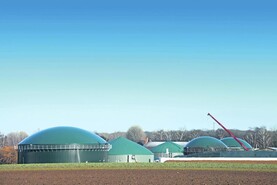There has been a lot of talk about anaerobic digestion (AD) over the last few months, as the Government launched the renewable gas strategy. One of the supposed selling points of AD is that it will help dairy farmers impacted by the existing, or future, cuts to the nitrates derogation by creating a new outlet for slurry.
In my opinion, this is a very ill-informed point of view, as the following example will demonstrate. Let’s look at the numbers for a typical dairy farm and presume for a moment that there is no derogation available. The example farm is milking an average of 90 cows on 40ha, which is a stocking rate of 2.25 cows/ha on the milking block – well below the Teagasc blueprint of 2.7 cows/ha.
There are another 10ha of outside land used to rear 20 of each age group of replacement heifers. Let’s also presume that the herd is in the middle band for nitrate excretion rate, so 92kg N/ha. Between the cows and the heifers, there is a total 9,800kg of nitrogen excreted annually.
Across the 50ha farm, this equates to 196kg N/ha of organic nitrogen excretion rate. This is below the current maximum stocking rate for those in a derogation at 220kg N/ha, but higher than the 170kg N/ha limit without derogation.
As things stand, this farmer would need to export slurry, reduce cow numbers or find additional land in order to get the organic nitrogen figure down to 170kg N/ha.
Let’s also presume that the farmer is currently spreading 200kg N/ha of chemical nitrogen on the farm, which is fairly typical of a farm at that stocking rate. This is in addition to spreading all of the slurry produced over the winter.
In order to get below 170kg N/ha organic stocking rate, the farm would need to reduce organic N by 27kg N/ha. This could be achieved by securing an extra 7.6ha of land, reducing cow numbers by 14 cows or by exporting 542,000l of slurry.
Exports
Based on the current regulations, which state that a dairy cow produces 330l of slurry per week over the course of a 16-week winter, the 90 cows would produce 475,000l of slurry. Now, there is general acceptance that the slurry excretion rates are outdated and are likely to be increased by 20% to 30%.
Let’s say that the actual slurry excretion rates are 30% higher, at 429l/cow/week. This would mean that the cows on this farm would produce 618,000l of slurry over a 16 -week winter. An additional 62,000l of slurry would be produced by the 20 yearling heifers over the winter, bringing the total amount of slurry produced on the farm to 680,000l.
This exceeds the amount that would need to be exported so, theoretically at least, the farmer could export their way out of the nitrates problem and still have 138,000l of slurry to spread on their own farm, with no additional land required or no cut to cow numbers.
Nitrogen
By exporting the slurry, the farmer would be reducing the organic nitrogen stocking rate to under 170kg N/ha. This puts the farm in a new category in terms of maximum chemical nitrogen allowance.
Rather than an upper limit of 254kg N/ha, as was the case when the farm was stocked between 170kg and 210kg organic N/ha, the upper limit for chemical nitrogen in the 131kg to 170kg organic N/ha is 185kg chemical N/ha. This is 15kg N/ha lower than the current application rate of 200kg N/ha, which this farmer has been applying. On top of that, the amount of slurry the farm has available for spreading is far less, as almost 80% of the slurry produced is exported, in this example to an AD plant.
According to the nitrates tables, each 1,000l of slurry contains 2.4kg of nitrogen, so the farmer is exporting 1,300kg of N in slurry annually, which is the equivalent of 26kg N/ha.
Across the farm, between less chemical nitrogen and less slurry nitrogen, the farm would be applying 41kg N/ha less nitrogen than before. At a response rate of say 25kg of grass per 1kg of N, the farm would likely grow over 1tDM/ha less grass as a result.
However, the key thing here is that the main value of slurry is not nitrogen, it’s phosphorus and potash.
If the national average soil fertility status for dairy farms was applied to this farm, then 21% or 10.5ha would be at index one, 26% or 13ha would be index two and three respectively, and 28%, or 14ha, would be at index four for phosphorus.
Based on the maximum phosphorus application rates in the nitrates directive, the total phosphorus allowance for this farm, based on the soil fertility, would be 815kg. This is before the amount supplied in meal is considered.
If the farmer feeds 1t of meal per cow annually, 315kg of phosphorus is assumed to be provided in meal, therefore the net chemical phosphorus allowance falls to 500kg, or 10kg P/ha.
With just 138,000l of slurry to apply on the farm and presuming 0.8kg of P per 1,000l of slurry, that means there would be 110kg of phosphorus supplied in slurry, or 2.2kg P/ha. When combined with chemical P, this brings the total amount of P on the holding to 610kg, or 12.2kg P/ha.
If the farmer needs 20ha of first-cut requiring 26kg P/ha and 20ha of second-cut requiring 18kg P/ha, they would need 2,200kg of phosphorus in total just for silage ground alone. There is, therefore, a shortfall of 1,590kg of P or, in other words, only 27% of the silage crop requirement can be met by the available nutrients. This ignores the fact that 47% of the soil is already deficient in P and that slurry is only 50% available at low soil index. It also ignores the P requirement for grazing land.
In summary, the typical dairy farm in this scenario that exports slurry in order to comply with a 170kg N/ha limit, either to an AD plant or to other farmers, will end up deficient in nitrogen and severely deficient in phosphorus.
Digestate
It’s at this point that digestate comes into the picture. Proponents of AD will argue that farmers who supply feedstock, in this case slurry, can get the digestate back in return.
Digestate is what is released from the AD plant after it goes through the process. It has similar N, P and K status as the feedstock and is classed as organic manure.
In the above example, the farm is stocked at 170kg N/ha and so has no allowance to import organic manure containing nitrogen as they cannot exceed the 170kg N/ha organic nitrogen limit. Therefore, they cannot import digestate back on to their farm.
However, the European Commission, under a scheme called RENURE, has recently agreed to consider organic manures that go through further nutrient processing as being in the same category as synthetic or chemical fertiliser.
On the face of it, this is good news, as it means farms, such as the one in this example, could import the processed digestate, perhaps in dried pellet form, instead of buying chemical nitrogen.
However, this doesn’t mean that additional nitrogen can be imported back into the farm, it just means that the bag nitrogen can be replaced with processed digestate, in this case up to 185kg N/ha.
Importantly, if the nitrogen in the processed manure is to be treated the same as chemical nitrogen, then the assumption is that the phosphorus in the processed digestate will be also.
This means that for the farm used in this example, they will be limited to importing just 610kg of P on to the holding, whether in chemical form or processed digestate form, grossly below what the farm requires.
Two further points on this; firstly, in order to qualify as RENURE, the digestate must be further processed which may be costly. Whether or not AD plants that go down this route will then “give away” the processed RENURE back to farmers at no or low cost remains to be seen.
Secondly, one potential work-around to the phosphorus issue is to separate slurry on-farm before exporting it. Slurry separators are commercially available to buy or hire per hour. In a Northern Ireland study, it was found that the solid fraction of centrifuge separated cattle slurry contained between 59% and 70% of the total phosphorus contained in the slurry.
It also found that the liquid fraction contained between 70% and 71% of the total nitrogen in the slurry.
However, the problem with this, other than the cost of separating slurry, is that AD plants want the solid fraction and not the liquid fraction. Exporting the solid fraction to AD plants will be beneficial in some places that have an excess phosphorus problem, such as in Northern Ireland and Denmark, but the problem in Ireland is phosphorus deficiency, not surplus.
Comment
From what I can see, the roll-out of anaerobic digestion will bring no benefits to dairy farmers concerned about the impact of cuts to the nitrates derogation.
For the typical dairy farmer, exporting slurry to overcome the derogation issue will lead to worse outcomes than reducing cow numbers to comply with any future cuts to the derogation.
This is true whether the slurry is exported to an AD plant or to another farmer.
The perceived advantage of getting digestate back in return for supplying slurry to an AD plant is effectively useless to a farmer operating at 170kg N/ha or above.






 This is a subscriber-only article
This is a subscriber-only article










SHARING OPTIONS: